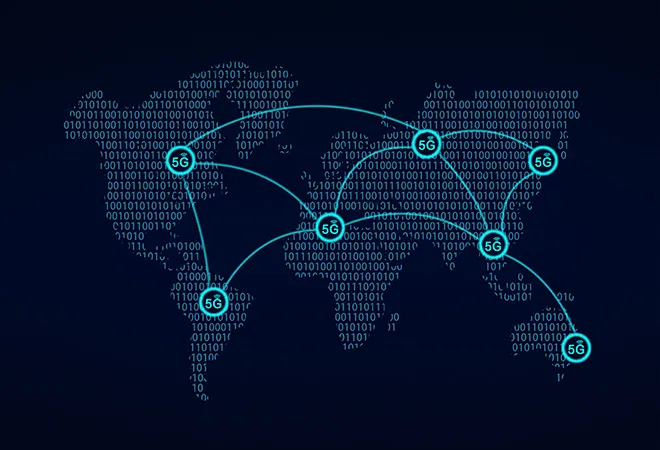
The roll-out of the 5G network, the next generation of global communications, has turned into a geopolitical confrontation between China and other western countries, led by the US. Of the few telecommunications companies that are ready to deploy 5G on a large scale, Huawei promises to provide the most affordable and technologically advanced alternative. Many nations consider this as a security risk and have flagged legal, political and economic concerns for sourcing the new communications infrastructure from a Chinese company. What is at the heart of this contestation is an attempt by the western nations, particularly the US, to prevent China from gaining global and economic clout as a first mover of the next gen technology. And as a result the battle for setting up the 5G network has become the latest flash-point for geopolitical competition between the US and China.
The rollout of the 5G network, the next generation of global communications, has turned into a geopolitical confrontation between China and other western countries, led by the US.
The 5G network promises increased data speed, ultra-low latency and near-instantaneous, high-capacity communication. Apart from improving network services for customers, it will enable machine-to-machine communications and develop applications like driver-less cars, smart cities and factory automation. Given the extensive and large scale applications possible for 5G network, it is a given that the network will support a steady stream of sensitive information and data. Further, operational aspects of 5G like its reliance on artificial intelligence, cloud networking, and greater integration of core and non-core network infrastructure, will make it difficult to impose tight cyber security controls. With 5G poised to become the backbone of the new digital revolution, there is a need to ensure that the network is not vulnerable to espionage and security breaches.
Operational aspects of 5G like its reliance on artificial intelligence, cloud networking, and greater integration of core and non-core network infrastructure, will make it difficult to impose tight cyber security controls.
Western nations, particularly the members of a Cold War era intelligence alliance known as the “Five eyes” have spearheaded the movement against Huawei’s 5G network. Their member countries comprise of the US, the UK, Canada, Australia and New Zealand. However, the response of the member countries have not been uniform across the board. Australia has out-rightly banned Huawei and has recently introduced the Telecommunications Sector Security Reforms (TSSR) to obligate network carriers to take steps to protect their networks and facilities from national security threats. The United Kingdom is presently considering restricting Huawei’s access to non-core networks and barring it from core networks. Last year the Government Communications Security Bureau (GCSB) rejected a bid by a New Zealand company to use Huawei gear on the grounds that it identified a ‘significant network security risk’.
Western nations, particularly the members of a Cold War era intelligence alliance known as the “Five eyes” have spearheaded the movement against Huawei’s 5G network.
The US, in particular, has approached the Huawei issue on a war footing. It recently enacted a law to prohibit US government agencies from using or procuring Huawei equipment, and has pressed criminal charges on the company and its personnel for violating Iran sanctions. The US is also actively dissuading its allies from including Huawei in their 5G network by deeming it as an “untrustworthy vendor”, and has gone as far as to say that it will rethink intelligence ties with them, should they choose to allow it.
The Trump Administration is looking at China’s drive to dominate the spectrum of emerging technologies from 5G and big data to robotics and artificial intelligence almost as an existential challenge – one which will not only cement China’s rise as the pre-eminent power of our times but will also allow Beijing to exercise influence beyond its borders to nations already in thrall to its growing economic heft. Where China views its aspirations regarding the tech race as legitimate, many in the West view them as a veneer for consolidating digital authoritarianism and cyber-war capabilities.
Where China views its aspirations regarding the tech race as legitimate, many in the West view them as a veneer for consolidating digital authoritarianism and cyber-war capabilities.
The security risks surrounding Huawei’s 5G network are not entirely unfounded. Though Huawei is a privately owned company, its founder Ren Zhengfei was a former engineer with China’s military and reportedly has close ties with the China’s Communist Party. The political environment in China has been notorious for close collaboration between the government and the industry, which may support possible industrial espionage. China’s framework of national security laws, such as the 2017 National Intelligence Law and the 2014 Counterintelligence law, also mandate that companies, individuals and entities should provide assistance and cooperation to national intelligence agencies. This is further compounded by fears that the network technology may come equipped with a “backdoor” which can bypass national security controls and access encrypted data.
The security risks surrounding Huawei’s 5G network are not entirely unfounded...The political environment in China has been notorious for close collaboration between the government and the industry, which may support possible industrial espionage.
China also stands to gain by playing an upper hand in not only setting standards for the network, but also by securing required intellectual property rights for the use of 5G technology. The use of standard essential patents (SEPs) to operationalize the network will mean that Huawei will receive royalties for licensing and will become a market leader in 5G technology. This will generate a steady revenue stream and further China’s economic rise and digital influence. It is also likely that the 5G network will form an important component of China’s proposed projects, such as the Digital Silk Road in Asian, African and Middle Eastern countries.
Washington’s actions so far seem to be driven by its larger program to restrict China gaining as a first mover advantages vis-à-vis this technology. Technology – particularly information and communications technology – have long played an important role in geopolitics. In the late 19th century, the United Kingdom was the first mover of telegraphy and submarine cable systems. By building these extensive communications network it was able to maintain channels of communication with its colonies abroad, and consolidate the erstwhile British Empire. The subsequent development of radar technology by the UK was what gave it an edge over the German challenge during World War II. Post 1945, the British hegemony was directly challenged by the US as it made rapid advancements in telephony, and was one of the first to deploy satellite communications system. Eventually, America’s extensive satellite networks were used by it and its allies to intercept and decode information during the cold war period. The US’ use of satellite technology to spy the flow of information and communication through American satellites is not so different from the concerns being raised regarding Huawei’s 5G network.
Washington’s actions so far seem to be driven by its larger program to restrict China gaining as a first mover advantages vis-à-vis this technology. Technology – particularly information and communications technology – have long played an important role in geopolitics.
While China stands to gain significantly by being the first mover of this technology, the US will continue its agenda and pressurize its allies against accepted Huawei’s telecommunications equipment. Western nations are also likely to give renewed impetus to developing alternative 5G networks. This can lead to the development of two politically and geographically divided 5G networks which may not be inter-operable, thereby leading to lower economies of scale and higher transaction costs. There is growing consensus in Washington that not only should advanced US technologies be kept out of China but Chinese technologies should also be kept outside critical US infrastructure. And Beijing, for its part, remains focused on reducing its reliance on the West for advanced technologies.
Western nations are also likely give renewed impetus to developing alternative 5G networks. This can lead to the development of two politically and geographically divided 5G networks which may not be inter-operable, thereby leading to lower economies of scale and higher transaction costs.
It is this contestation that will shape not only the emergence of the next generation of technologies but also the course of global politics in the coming years. As the world passes through a phase of unprecedented technological transformation, geopolitical competition among the world’s two most important powers is only likely to become more pronounced. Other nations, including India, should be well aware of the consequences of this unfolding dynamic and prepare accordingly to meet the challenges of this emerging geopolitics of technology.
The views expressed above belong to the author(s). ORF research and analyses now available on Telegram! Click here to access our curated content — blogs, longforms and interviews.




 PREV
PREV



